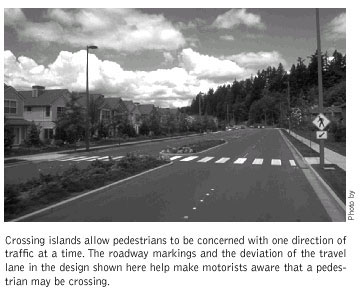25. Crossing Islands
Crossing islands--also known as center islands, refuge islands, pedestrian islands or median slow points--are raised islands placed in the center of the street at intersection or midblock locations to help protect crossing from motor vehicles. Center crossing islands allow pedestrians to deal with only one direction of traffic at a time, and enable them to stop part-way across the street and wait for an adequate gap in traffic before crossing the second half of the street. Where midblock or inter-section crosswalks are installed at uncontrolled locations (i.e., where no traffic signals or stop signs exist), crossing islands should be considered as a supplement to the crosswalk. They are also appropriate at signalized crossings. If there is enough width, center crossing islands and curb extensions can be used together to create a highly improved pedestrian crossing.
This kind of facility has been demonstrated to decrease the percentage of pedestrian crashes and casualties by 57-82%. The factors contributing to pedestrian safety include reduced conflicts, reduced vehicle speeds approaching the island (if designed as such the approach can be designed to force a greater or lesser slowing of cars, depending on how dramatic the curvature is), greater attention called to the existence of a pedestrian crossing, opportunities for additional signage in the middle of the road, and reduced exposure time for the pedestrians.
Curb extensions may be built in conjunction
with center crossing islands where there is on-street parking, Care should
be taken to maintain bicycle access. Bicycle lanes (or shoulders, or whatever
space is being used for bicycle travel) must not be eliminated or squeezed
in order to create the curb extensions or islands. 

Purpose:
- Enhances pedestrian crossings, particularly at unsignalized crossing points.
- Reduces vehicle speeds approaching pedestrian crossings.
- Highlights pedestrian crossings.
Considerations:
- Do not squeeze bicycle access.
- Illuminate or highlight islands with signs and reflectors to ensure that motorists see them.
- Design islands to accommodate pedestrians in wheelchairs. A cut-through design such as depicted in the diagram works best.
- Crossing islands at intersections or near driveways may affect left turn access.
Estimated cost
Costs range from $6,000 - $9,000. The cost for installing a raised concrete pedestrian refuge island (with landscaping) is about $10,000 to $30,000. The cost is less for an asphalt island or one without landscaping.